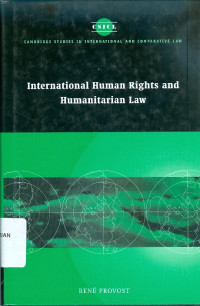
Text
International human rights and humanitarian law
How do international human rights and humanitarian law project vulnerable individuals in times of peace and war? Analysis systemic similarities and differences in the construction of each body of law, showing how they achieve a similar goal. Reveals how each performs a task for which it is better suited than other, and that the fundamentals of both fields remain partly incompatible. As a form of international law, international human rights law is primarily made up of treaty law - legally binding agreements between State parties - and customary international law - rules of law derived from the consistent practice of States. While international treaties and customary law form the mainstay of international human rights law, other instruments, such as declarations, guidelines and principles adopted at the international level contribute to its understanding, implementation and development. Enforcement of international human rights law can occur at either a domestic or an international level. States that ratify human rights treaties commit to respecting, protecting and fulfilling those rights, and ensuring that their domestic law is compatible with international standards. When domestic law fails to provide a remedy for human rights abuses, injured parties may be able to resort to international mechanisms for remedy. International human rights law is closely related to, but distinct from international humanitarian law. They are complimentary since the substantive norms they contain are often similar or related. However, international human rights law applies at all times, including during situations of emergency and conflict. International humanitarian law is a legal regime that only applies to armed conflicts, including occupation, when both legal regimes apply in tandem.
Availability
| KP.1 000256 | KP.1 PRO I | My Library | Available |
Detail Information
- Series Title
-
Cambridge Studies in International and Comparative Law
- Call Number
-
KP.1 PRO i
- Publisher
- Cambridge : Cambridge University., 2002
- Collation
-
xxxix, 418p. ; 23cm.
- Language
-
English
- ISBN/ISSN
-
0521806976
- Classification
-
KP.1
- Content Type
-
-
- Media Type
-
-
- Carrier Type
-
-
- Edition
-
-
- Subject(s)
- Specific Detail Info
-
-
- Statement of Responsibility
-
-
Other version/related
No other version available
File Attachment
Comments
You must be logged in to post a comment
 Computer Science, Information & General Works
Computer Science, Information & General Works  Philosophy & Psychology
Philosophy & Psychology  Religion
Religion  Social Sciences
Social Sciences  Language
Language  Pure Science
Pure Science  Applied Sciences
Applied Sciences  Art & Recreation
Art & Recreation  Literature
Literature  History & Geography
History & Geography